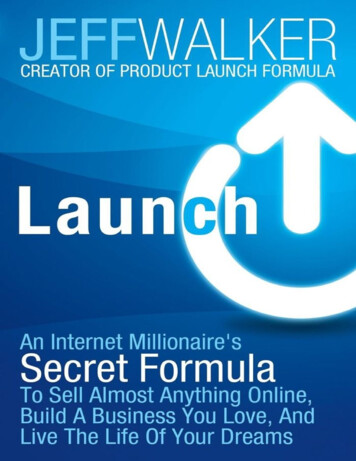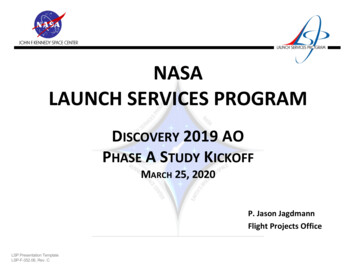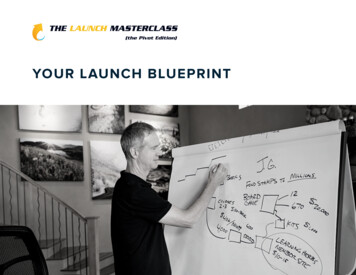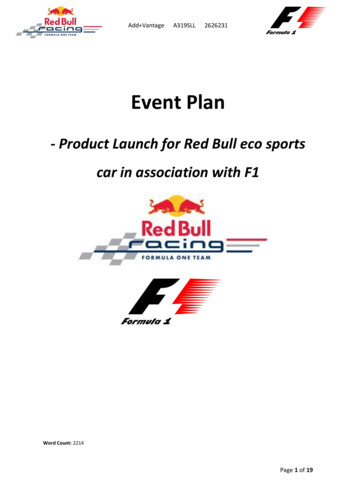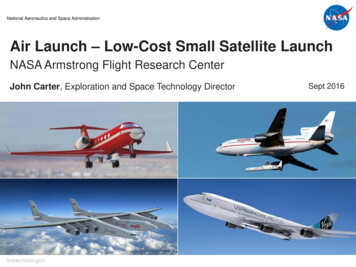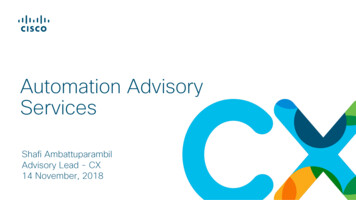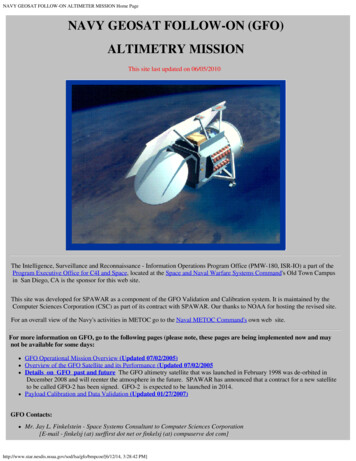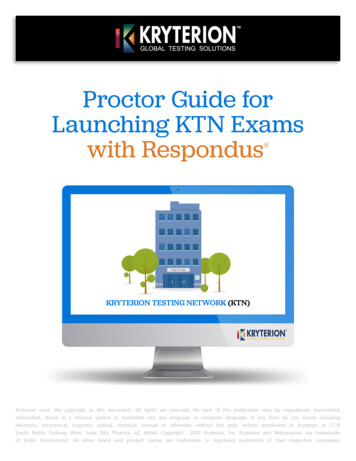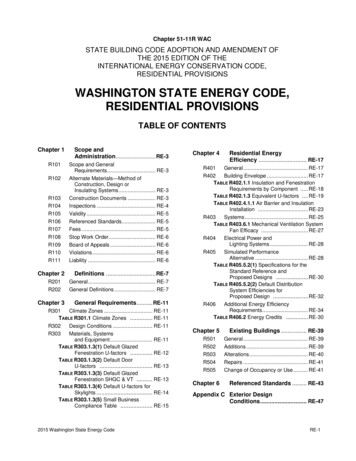
Transcription
MomentumengineeringAcross Disciplines. Across the World //fall 2016{launch code}LaunchCode, WashU Engineering teamto meet demand for tech professionalsi n s i d e Srikanth Singamaneni 18 // Passion for the world 22 // Lorrie Cranor 28
From the dean //We are planning for our future. Pleaseshare your thoughts and insights forWashU Engineering’s next strategic plan:engineering.wustl.edu/strategicplan— be they ligaments or trusses — emerge from thecharacteristics of the smaller-scale elements. As you readabout Srikanth Singamaneni’s research on nanoparticlesor the new NSF Science and Technology Center focusedon cellular mechanobiology (a new word for me), Ihope you’ll come to appreciate that we can control andengineer processes at these small scales, giving greatpower eventually in the large.Dear friends,A university runs with a strong annual rhythm, and onereally has to experience the full academic year beforedeveloping a feel for the place. Though it’s hard to believeit is already my second year, I do have a much strongerunderstanding of not just WashU, but also the strengthsand opportunities in the Engineering school.As you can read in the following pages, you willfind our students and faculty have achieved greataccomplishments this past year. I have experiencedrepeatedly that our undergraduates are truly giftedlearners, which is perhaps unsurprising given the qualityof the incoming first-year students. But as you can readin the LaunchCode story, they also engage with ourcommunity, connecting the intellectual powerhouse thatis WashU to the broader social fabric. And, as you will alsoread, our students represent the four corners of the earth.This not only brings a variety of perspectives to theirresearch, but it also means that our work reaches back tohelp advance the global quality of life.Of course as a premier research university, the work ofthe faculty and their research-engaged students is whatdrives the school forward. One surprising element forme about WashU Engineering is the importance of workat the smallest scales. In fields ranging from medicine toenergy to materials, the properties of larger structuresSnapshot //Doctoral student Claire Fortenberryworks in the Atmospheric Chemistry andTechnology Lab, led by Associate ProfessorBrent Williams. Her research interestsinclude characterizing the oxidationchemistry of secondary organic and biomassburning aerosols.devon hillHaving spent a year listening and learning, it is nowtime for us to focus strategically on developing areas inwhich we can operate at a truly world-class level, both inresearch and education. This fall, we started a “bottomup” strategic planning effort designed to solicit ideasfrom all our stakeholders: undergraduate and graduatestudents; faculty and staff within the Engineering schooland colleagues across the university; alumni; industrypartners and other friends. The strategic planningcommittee will continue to solicit, gather and synthesizethese ideas into a set of white-paper initiatives, eacharticulating a specific set of goals, a means of assessingprogress and the specific tactical steps that must betaken to advance the agenda. The idea is to not only havea strategy-defining document — the traditional strategicplan — but also a set of action plans that we can beginto implement immediately. The entire process will becompleted by mid-spring, so you will be hearing morefrom us.Here’s to a great sophomore year.Aaron F. BobickDean & James M. McKelvey Professorafb@wustl.edufall 2016//Engineering Momentum1
In this issue //THEBUZZfall 2016deanAaron F. BobickAt a glance //#WashUengineersGeneoscopy has developed a proprietary andnovel technology to pull down and evaluatehuman biomarkers in intestinal cells thatare sloughed off from the colonic walls.This method allows Geneoscopy to directlyevaluate stool samples for human markerswithin cancer and pre-cancerous cells.18associate dean &executive editorNick Benassisenior writer & editorBeth Millercreative servicesdirector & designerE. Brook HaleyFrom left: Andrew Barnell, Erika Barnell, MD/PhD student, and Yiming Kang, PhD student inComputer Science.digital communicationsKristen OttocommunicationsspecialistSuzanne Bremehrweb developerVince RuppertStudent start-up: GeneoscopycontributorsErika Ebsworth-GooldTony FitzpatrickRuben SchuckitChristopher Tritto22Engineering Momentum ispublished by the School ofEngineering & Applied Scienceat Washington University inSt. Louis. Unless otherwise noted,articles may be reprinted withoutpermission with appropriatecredit to the publication, schooland university.correspondenceSchool of Engineering& Applied ScienceWashington University in St. LouisCampus Box 1163One Brookings DriveSt. Louis, MO 63130-489928cover story12//LaunchCodefaculty featurein every issue18//Srikanth Singamaneni//From the dean3//At a glance4//School newsalumni featureemailmagazine@seas.wustl.edu6//Faculty news28phone(314) 935-635037//Last word22////Passion for the worldLorrie Cranoryoung alumni feature32websiteengineering.wustl.eduWashU students waited in Whitaker Hall Oct. 9 to hear theresults of the debate ticket lottery. In total, 352 tickets weregiven to students.student feature1//Amanda Albrechtspecial feature332geneoscopy//Arye NehoraiFrank Wilson, alumnus and lecturer in the WashU/UMSL Joint UndergraduateEngineering Program, was honored by the City of St. Louis Oct. 5 for his serviceto the community and contributions to the construction industry.See more about the debate on p. 36ArchHacksnov. 4-6, 2016ArchHacks, a hackathonhosted by WashU, broughttogether more than 500students from around thecountry for 48 hours ofcollaboration, problemsolving and building. TheHealthTech theme focusedon innovative technology.photos by brian l amEngineering Momentum//engineering.wus tl .edufall 2016//Engineering Momentum3
School news //Ju, Turner namedvice deans in EngineeringNew faculty join WashU EngineeringWashington University to invest 25 millionin imaging sciences during next five yearsDamena D. AgonaferVijay RamaniQuing Zhu»» Assistant Professor in theDepartment of Mechanical Engineering& Materials Science»» Professor in the Department of Energy,Environmental & Chemical Engineering»» Professor in the Department ofBiomedical Engineering»» PhD, chemical engineering,University of Connecticut»» PhD, bioengineering, University ofPennsylvania»» Ramani’s research focuses on a varietyof areas, including corrosion resistancein mixed-metal oxide electrocatalystmaterials; anion conducting polymers insitu electrochemical diagnostics to probeelectrochemical systems; microstructureproperty relationships in porouselectrodes; hybrid polymer electrolytes;degradation mitigation through in situradical scavenging and bifunctionalelectrocatalysts.»» Zhu combines ultrasound and nearinfrared (NIR) imaging modalitiesfor clinical diagnosis of cancers. Thiscombined approach overcomes thelocalization uncertainty of opticalreconstruction and improves theultrasound diagnosis. She and her teamhave explored the theory and modelingbehind this novel technique and haveconducted clinical studies at the UConnHealth Center and Hartford Hospital.Initial results have shown great successin early diagnosis of malignant andbenign breast lesions and in predictingand monitoring breast cancer treatmentresponse using this technique. Herpioneering research has now beenheralded by the imaging and radiologycommunity as an important advance insociety’s ability to distinguish benign andmalignant lesions in the breast.»» PhD, mechanical science and engineering,University of Illinois at Urbana-Champaign»» Agonafer’s research focuses on theintersection of thermo-fluid sciences,electrokinetic and interfacial transportphenomena and renewable energy. Alvitta Ottley»» Assistant Professor in the Department ofComputer Science & Engineering»» PhD, computer science, Tufts University»» Ottley’s research focuses on designingpersonalized and adaptive visualizationsystems, including informationvisualization, human-computerinteraction, visual analytics, individualdifferences, personality, user modelingand adaptive interfaces.Kimberly M. Parker»» Assistant Professor in theDepartment of Energy, Environmental& Chemical Engineering»» PhD, environmental engineering &science, Stanford University»» Parker investigates environmentalorganic chemistry in natural andengineered systems. She also is exploringhow hydraulic fracturing can impactdownstream drinking water quality.4Engineering Momentum//engineering.wus tl .eduPatricia Weisensee»» Assistant Professor in theDepartment of Mechanical Engineering& Materials Science»» PhD, in mechanical science andengineering, University of Illinois atUrbana-Champaign (December 2016)»» Her research interests include solidstate and phase change heat transfer,two-phase flows, droplet impact andwettability of surfaces.“These faculty members will bolster already-strong areas ofresearch and add new areas of inquiry to our research portfolio.With these new hires, the school is on track to reach 100 facultymembers by 2020.”— a aron bobickBuilding on its extensive history inimaging — from individual cells andnerves to cancerous tumors andAlzheimer’s plaques — WashingtonUniversity in St. Louis is launching abold 25 million initiative to supportresearchers across the university asthey develop innovative technologiesaimed at improving science andmedicine worldwide.Initially, the Imaging SciencesInitiative, a partnership betweenthe School of Engineering & AppliedScience and the School of Medicine,will bring in more than a dozen newfaculty with strengths in variousaspects of imaging sciences. Bothschools have their own long-standingstrengths in the field, with more than300 imaging scientists between them.The new initiative strengthens theconnection between the schools andencourages the development of newimaging technologies to diagnose andtreat disease as well as study intricatebiological structures, metabolism andphysiology, and critical molecular andcellular processes.“This initiative allows us toattack challenges in imaging that canonly be addressed by collaborationsbetween medicine and engineering,including developing fundamentalnew technologies and advancedcomputational methods,” said AaronF. Bobick, dean of the School ofEngineering & Applied Science andthe James M. McKelvey Professor.“Washington University will furtherestablish its place at the forefrontof groundbreaking biomedicalengineering and imaging researchthat can have an immediate impact inthe world.”Setton named Lopata DistinguishedProfessor of Biomedical Engineeringlori set tonLori Setton, a renowned researcher intothe role of the degeneration and repair ofthe body’s soft tissues, has been namedthe Lucy and Stanley Lopata DistinguishedProfessor of Biomedical Engineering atWashington University in St. Louis. Shewas installed Oct. 24 in a ceremony atWhitaker Hall. Setton joined the School ofEngineering & Applied Science faculty in2015 from Duke University.Tao Ju and Jay Turner havebeen named vice dean ofresearch and vice dean foreducation, respectively, inthe School of Engineering& Applied Science by DeanAaron Bobick.Ju, professor ofcomputer science &engineering, is recognizedtao juas a leader in computergraphics and biomedical modeling research. Inhis research, funded by both the National ScienceFoundation and the National Institutes of Health, hehas collaborated with faculty across the university,including at the School of Medicine as well as withseveral international investigators.In the new role of vicedean for education, Turnerwill lead the schoolwideeffort to enhance theundergraduate studentexperience in considerationof what is taught and thebest way to teach the nextgeneration of engineersand leaders. Turner hasjay turnerserved as director ofundergraduate programs in the Department ofEnergy, Environmental & Chemical Engineering andhas received several teaching awards, including theinaugural Dean’s Award for Excellence in Teachingand the school’s Professor of the Year Award.Jain named Cox Professor inComputer Sciencer a j jainRaj Jain has been named the BarbaraJ. and Jerome R. Cox, Jr. Professorin Computer Science at WashingtonUniversity in St. Louis. He was installedMay 24. Jain is a professor of computerscience & engineering in the School ofEngineering & Applied Science, wherehe has been on the faculty since 2005.Previously, he was on the faculty at theOhio State University.fall 2016//Engineering Momentum5
Faculty news //Engineers to use cyborg insects as bioroboticsensing machinesBarani Raman, associate professor of biomedical engineering, has received athree-year, 750,000 grant from the Office of Naval Research (ONR) to use thehighly sensitive locust olfactory system as the basis to develop a bio-hybrid nose.Joining Raman in the research are Srikanth Singamaneni, associate professor ofmaterials science, and Shantanu Chakrabartty, professor of electrical & systemsengineering, all in the School of Engineering & Applied Science.Biological sensing systems are far more complex than their engineeredcounterparts, including the chemical sensing system responsible for our senseof smell, Raman says. Although the sense of smell is a primitive sense, it isconserved across many vertebrate and invertebrate species.“It appears that biology converged onto a solution for the problem ofnon-invasive, or ‘standoff’ chemical sensing, and has replicated the samedesign and computing principles everywhere,” Raman says. “Therefore,understanding the fundamental olfactory processing principle is necessary toengineer solutions inspired by biology.”Building a better internetThe team of engineersled by Patrick Crowley,professor of computerscience & engineering,has received a 499,960three-year grant to focuson further developing theconcept of Named DataNetworking (NDN).patrick crowle y“The two big issuesfor most people whenthey think about the internet are how can it becomemore trustworthy and if can it really accommodateall the devices that we want to connect to it,” saidCrowley. “It’s in that context that NDN emerged as anetwork architecture idea.”Crowley says complications with the internet’scurrent framework arose because it’s based on arelative antiquity: the telephone and its model ofcommunication. Two devices are used, a channelis opened between them and communication isshared, without accommodating specific requests.NDN has emerged as the best possible solutionto widen the communication model. While thetelephone framework addresses the “where”of online addresses and hosts, NDN is furtherinclusive, handling the “what” that’s specific to theexact content a user expects to be delivered.Written by Erika Ebsworth-Goold6Engineering Momentum//engineering.wus tl .eduBuilding smarter, safer infrastructureA team of engineers is turning to cloud computing for a smarter,self-monitoring solution that can better sound the alarm in specificcases of infrastructure failure. The concept got its first test when itwas installed Sept. 21 on Michigan’s Mackinac Bridge, the largestsuspension bridge in the Western Hemisphere.“Right now, the maintenance of infrastructure has an enormouscost,” said Shantanu Chakrabartty, professor of electrical & systemsengineering at the School of Engineering & Applied Science. “It’s hardto know how to prioritize. So if you have data, you can do conditionbased maintenance. Depending on which part of a structure isvulnerable, you can assign manpower according to that.”The National Science Foundation has awarded Chakrabartty’steam a four-year, 1.1 million grant to develop long-term monitoringof our country’s infrastructure. The goal: to create smart civilinfrastructure that can self-monitor, enabling it to predict anyfailures in case of an extreme event such as an earthquake or flood,and also to prioritize areas for emergency response.Written by Erika Ebsworth-GooldNSF announces new Scienceand Technology CenterWashington University–Penn partnership willinvestigate biology’s mechanicsThe National ScienceFoundation (NSF)has added a newlyformed collaborationbetween WashingtonUniversity in St. Louisand the University ofPennsylvania to itslist of Science andguy geninTechnology Centers(STC). The center andits collaborative efforts will be supported by a 23.6 million grant from the NSF.“This award from the National ScienceFoundation reflects outstanding facultyachievement at Washington University inSt. Louis,” Chancellor Mark S. Wrighton said.“As the university advances its commitmentto groundbreaking, high-impact research,winning the new Science and TechnologyCenter is a major accomplishment.”The Science and Technology Center forEngineering MechanoBiology (CEMB) will bringtogether a consortium of researchers, includingengineers, biologists and biophysicists. Thegroup’s mission: identify and harness themechanical functions of both plants andanimals at the cellular level. Mechanical force isa critical component of all biological systems,allowing cells to divide, migrate, adapt anddifferentiate. It is hoped that this deeper diveinto how single cells function will transformboth medicine and plant science.“The STC grant represents significantsupport from the National Science Foundationfor a large-scale, complex researchundertaking,” said Dedric Carter, vicechancellor for operations & tech transfer atWashington University. Carter, a former senioradviser for strategic initiatives at the NSF,participated as part of Washington Universitysenior leadership during the site visit process.“This is a remarkable opportunityfor Washington University to advance itsinternational leadership in research andinnovation in a potentially transformativearea,” Carter said. “We look forward to thegreat work that will likely emerge from thisnew center.”“Mechanobiology has incrediblepotential,” said Guy Genin, professor ofmechanical engineering & materials science inthe School of Engineering & Applied Science,and principal investigator of WashingtonUniversity’s portion of the grant. “It couldchange the way we view many of the world’smost complex questions and issues.“For the field to fully realize its enormouspotential, a large commitment and scope ofstudy is needed,” Genin said. “We are mostgrateful for the National Science Foundation’ssupport. Being named an STC is a prestigiousdistinction reserved for sweeping researchprojects that have the power to change lives.We’re ready to get to work.”“The possible advancesthat could be realized withthis research team and ourcollaborators are nearlylimitless. If we can overridecellular mechanical behavior,we could stop cancer cellsfrom metastasizing. We couldalso improve our bodies’system functions and vastlychange the way we approachinjuries, with the potentialto speed up rehab.”— guy geninWritten by Erika Ebsworth-Gooldfall 2016//Engineering Momentum7
Brain’s activity, healthin coma focus ofWashU studyShiNung Ching, assistant professorof electrical & systems engineering inthe School of Engineering & AppliedScience, and Terrance Kummer, MD,assistant professor of neurology inthe School of Medicine, have receiveda two-year, 403,625 grant from theNational Institute of NeurologicalDisorders and Stroke of the NationalInstitutes of Health to develop amethod termed Network ReachabilityAnalysis (NetRA).When a patient is in a coma, oftenafter a traumatic brain injury (TBI), hisor her brain is not functioning — itselectrical activity is disrupted — whichcan lead to long-term disability.Physicians and researchers are lookingto improve treatment and outcomesof patients, but need a betterunderstanding of what causes coma.“We have specific treatments fortypes of coma, but often struggle toidentify the root cause,” Kummer said.“We’re hoping to better understandthese causes by analyzing theirelectrical effects on the brain.”Ching and Kummer plan to takebedside electroencephalogram (EEG)recordings from patients diagnosed withcoma in the Neurology/NeurosurgeryIntensive Care Unit at Barnes-JewishHospital in St. Louis, then createmathematical models with NetRA todetermine the causes of the coma.8Engineering Momentum//engineering.wus tl .eduDirty to drinkableHuntington’s diseasetarget of 4.5 million inNIH grantsRohit V. Pappu, the Edwin H. MurtyProfessor of Engineering in the Schoolof Engineering & Applied Science, hasreceived two grants from the NationalInstitutes of Health totaling more than 4.5 million to study the causes behindthis disease that may ultimately provideclues for a treatment or cure.“We are hoping that we can makeprofilin a better profilin,” Pappu said. “Wecan use it for mimicry purposes and alsoas an entity that gives us rules that we canadapt to other proteins that might interactwith other aggregation-prone moleculesthat are implicated in diseases other thanHuntington’s, such as Parkinson’s diseaseand Alzheimer’s disease.”Positively charged:Engineers win 2 milliongrant to design betterbatteriesVijay Ramani, an expert in electrochemicalengineering and renewable energyintegration at Washington University,has received a 2 million grant from theU.S. Department of Energy’s AdvancedResearch Projects Agency–Energy (ARPA-E)to create a new membrane that can be usedin batteries for grid-scale electric energystorage.Ramani’s team will use inexpensivecommercial polymers to create themembrane for redox flow batteries, whichare rechargeable batteries that storeelectricity in chemical solutions duringcharging and release electricity on demandwhile discharging. The layered membrane,which the team will make functional with ananopowder, prevents the chemicals in thetwo sides of the battery from mixing, whichwould lead to a chemical short circuit, whileenabling ions to flow effectively betweenthe solutions. A key novelty is that thismembrane would also allow for differentchemical combinations to be used at eachelectrode of the battery, which increasesversatility while lowering costs. Ramani’s labwill primarily investigate cerium, iron andchromium couples in their research.Graphene oxide has been hailed as a veritablewonder material. When incorporated intonanocellulose foam, the lab-created substanceis light, strong and flexible, conducting heatand electricity quickly and efficiently.Now, a team of engineers at WashingtonUniversity has found a way to use grapheneoxide sheets to transform dirty water intodrinking water, and it could be a global gamechanger.A closer look insideMark Anastasio, professor ofbiomedical engineering, will usea four-year, 2.2 million grantfrom the National Institutes ofHealth (NIH) to create a newX-ray technique that will assistengineers as they develop newbioengineered tissues.“We are developing a newimaging technology based onphase-contrast X-ray imaging,”Anastasio said. “It will serveas an enabling technology fortissue engineering studies.”A typical X-ray image forms as radiation that is absorbed by tissues and bones,providing doctors with a look inside the body. Anastasio’s new technology doesn’trely entirely on the absorption of X-ray energy, it also exploits wave optic effects,measuring the X-ray’s refractions for a much more precise peek inside.Faculty team awarded 1.25 million to study‘swimming cells’“We hope that for countries where thereis ample sunlight, such as India, you’ll be ableto take some dirty water, evaporate it usingour material, and collect fresh water,” saidSrikanth Singamaneni, associate professor ofmechanical engineering & materials science atthe School of Engineering & Applied Science.The new approach combines bacteriaproduced cellulose and graphene oxide toform a bi-layered biofoam. A paper detailingthe research is available online in AdvancedMaterials.“The process is extremely simple,”Singamaneni said. “The beauty is that thenanoscale cellulose fiber network produced bybacteria has excellent ability move the waterfrom the bulk to the evaporative surface whileminimizing the heat coming down, and theentire thing is produced in one shot.“The design of the material is novel here,”Singamaneni said. “You have a bi-layeredstructure with light-absorbing graphene oxidefilled nanocellulose at the top and pristinenanocellulose at the bottom. When yoususpend this entire thing on water, the wateris actually able to reach the top surface whereevaporation happens.”Written by Erika Ebsworth-GooldThe wavelike motions offlagella have been known sinceAntony van Leeuwenhoekobserved swimming spermcells and protozoa in the 1600s;how they do it remains muchless clear.“They spontaneouslybeat,” said Philip Bayly, theLilyan and E. Lisle Hughes Professor ofMechanical Engineering and chair of theDepartment of Mechanical Engineering& Materials Science at the School ofEngineering & Applied Science. “Buthow they beat is really a mystery.”A team from Washington University,comprised of engineering faculty andfaculty from Washington UniversitySchool of Medicine in St. Louis, has beenawarded a five-year, 1.25 million grantfrom the National Science Foundation(NSF) to study how these tiny organellesactually work. Unlike the oscillations ofa heartbeat, which are well documentedand explained, the cyclical behaviorof cilia and flagella remains an activeresearch area.“We understand the basics,” Baylysaid. “There are motor-proteins thatmust be responsible for the movement,but why things move back and forth asopposed to just moving in one directionis a mystery. It’s a problem thatintrinsically needs an interdisciplinaryteam to work on it.”The entire team will examine themovement and mechanics of flagellain a green alga called Chlamydomonasreinhardtii, or Chlamy, an unlikely butnearly perfect research substitute forhuman cells.Written by Erika Ebsworth-GooldRead full stories and other news: engineering.wustl.edu/newsfall 2016//Engineering Momentum9
Engineering a better biofuelWhile the bacteria E. coli is oftenconsidered a bad bug, researcherscommonly use laboratory-adaptedE. coli, which lacks the featuresthat can make humans sick but cangrow just as fast. That same qualityallows it to transform into the tiniestof factories: when its chemicalproduction properties are harnessed,E. coli has the potential to crank outbiofuels, pharmaceuticals and otheruseful products.Now, a team from the Schoolof Engineering & Applied Science has developed a way to make the production of certainbiofuels in E. coli much more efficient. Fuzhong Zhang, assistant professor of energy,environmental & chemical engineering, along with researchers in his lab, have discovered anew method to cut out a major stumbling block to the production process.Their findings were recently published in the journal Metabolic Engineering.“It’s a critical step that we’ve figured out how to solve this problem,” Zhang said.Written by Erika Ebsworth-GooldEngineering team toimprove wirelessnetwork technologyA team of engineers will work to solve thelost data problem in industrial applicationswith a three-year, 500,000 grant from theNational Science Foundation by approachingthe communication from both ends of thespectrum: the controller and the network.Humberto Gonzalez, assistant professorof electrical & systems engineering, leadsthe team, which includes Chenyang Lu, theFullgraf Professor in the Department ofComputer Science & Engineering, both in theSchool of Engineering & Applied Science, aswell as PR Kumar, professor and College ofEngineering Chair in Computer Engineeringat Texas A&M University, who received a 250,000 grant as part of the collaboration.Industrial processes, such as thoseat an oil refinery, begin with a controller,or a computer that sends and receivessignals, driven by code, to the plant, suchas when to open and close valves or to turn10Engineering Momentum//engineering.wus tl .eduthe boiler on and off. In the past, thosesignals were sent over vast lengths ofwire. However, new technology is wireless,requiring a very different code. A wirelessnetwork also is prone to communicationdelays and dropped packets, or digitalinformation, which is disruptive toproduction in an industrial setting.Gonzalez, a systems engineer whoworks in control, and Lu, a wireless networkexpert, plan to develop a new generationof industrial wireless control in which thecontroller and the wireless network cancommunicate in real time more efficiently.Waste not, wantnot: Discarded plantmaterial could replacepetroleum in chemicalsMarcus Foston, assistant professorof energy, environmental & chemicalengineering, has received a threeyear, 224,970 grant from the NationalScience Foundation to find catalyststhat will break down lignin, a tough partof the cell walls of woody and grassyplants, into chemicals that can be usedas building blocks for materials. Hewill collaborate with Susannah Scott,professor of chemical engineeringand of chemistry and biochemistry atUniversity of California, Santa Barbara,who also received 225,000, bringing thetotal grant amount to 449,970.Foston, who specializes in usinglignin characterization and conversion,said plants developed lignin as aprotective mechanism from microbesand fungi, so it is difficult to break downand is often discarded or burned forpower or heat. Instead of wasting thismaterial left over from papermaking orbioethanol production, Foston is lookingto pull it out of the cell wall to use itschemical structure for products.“We are looking to developcatalysts and to understand thestructures of catalysts that allow us topull out the aromatic building blocksfrom lignin in a very selective way,”Foston says.Fighting crime at the intersection ofscience and social justiceResearchers from WashingtonUniversity are using science tofight crime, developing a hightech approach to combat the sextrafficking trade. Teaming up witha nonprofit organization called theExchange Initiative, Robert Pless,professor of computer science& engineering in the School ofEngineering & Applied Science, andresearch associate and doctoralcandidate Abby Stylianou havecontribute data to fight thesehorrible crimes; and
Frank Wilson, alumnus and lecturer in the WashU/UMSL Joint Undergraduate Engineering Program, was honored by the City of St. Louis Oct. 5 for his service to the community and contributions to the construction industry. nov. 4-6, 2016 ArchHacks, a hackathon hosted by WashU, brought together more than 500 students from around the
